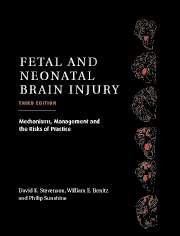Book contents
- Frontmatter
- Contents
- List of contributors
- Foreword
- Preface
- Part I Epidemiology, Pathophysiology, and Pathogenesis of Fetal and Neonatal Brain Injury
- Part II Pregnancy, Labor, and Delivery Complications Causing Brain Injury
- Part III Diagnosis of the Infant with Asphyxia
- 20 Clinical manifestations of hypoxic–ischemic encephalopathy
- 21 The use of the EEG in assessing acute and chronic brain damage in the newborn
- 22 Structural and functional imaging of hypoxic–ischemic injury (HII) in the fetal and neonatal brain
- 23 Near-infrared spectroscopy and imaging
- 24 Placental pathology and the etiology of fetal and neonatal brain injury
- 25 Correlations of clinical, laboratory, imaging and placental findings as to the timing of asphyxial events
- Part IV Specific Conditions Associated with Fetal and Neonatal Brain Injury
- Part V Management of the Depressed or Neurologically Dysfunctional Neonate
- Part VI Assessing the Outcome of the Asphyxiated Infant
- Index
- Plate section
23 - Near-infrared spectroscopy and imaging
from Part III - Diagnosis of the Infant with Asphyxia
Published online by Cambridge University Press: 10 November 2010
- Frontmatter
- Contents
- List of contributors
- Foreword
- Preface
- Part I Epidemiology, Pathophysiology, and Pathogenesis of Fetal and Neonatal Brain Injury
- Part II Pregnancy, Labor, and Delivery Complications Causing Brain Injury
- Part III Diagnosis of the Infant with Asphyxia
- 20 Clinical manifestations of hypoxic–ischemic encephalopathy
- 21 The use of the EEG in assessing acute and chronic brain damage in the newborn
- 22 Structural and functional imaging of hypoxic–ischemic injury (HII) in the fetal and neonatal brain
- 23 Near-infrared spectroscopy and imaging
- 24 Placental pathology and the etiology of fetal and neonatal brain injury
- 25 Correlations of clinical, laboratory, imaging and placental findings as to the timing of asphyxial events
- Part IV Specific Conditions Associated with Fetal and Neonatal Brain Injury
- Part V Management of the Depressed or Neurologically Dysfunctional Neonate
- Part VI Assessing the Outcome of the Asphyxiated Infant
- Index
- Plate section
Summary
Theory of near-infrared spectroscopy and applications
Development of light-based diagnostic systems
Transillumination, or the passage of light through the body, is a concept that has been studied since the early 1800s. Initial attempts to image organs and tissues for the purpose of diagnosis and treatment have developed significantly over the years; light-based monitoring in the form of pulse oximetry is now relied upon daily in hospitals and clinics. Transillumination of the head, first described in 1831 by Richard Bright, would later be recognized as the first light-based diagnosis of hydrocephalus. The technique was modified and, although still crude, was used to diagnose intracranial hemorrhage in the neonate at a time when head ultrasound was not yet in use, and computed tomography (CT) was extremely expensive and not widely available.
The early light-based devices for brain-imaging employed broad-spectrum visible light sources, whereas in more recent developments light over a narrower band of wavelengths has been used. However, in 1977, Jobsis showed that, if near-infrared (NIR) light, with a wavelength of 700–1000 nm, was used instead of visible light, absorption by tissue was low enough for spectral measurements to be made across the head of an animal with a diameter of 5–6 cm. Using light in this wavelength band affords enormous potential diagnostic benefits far beyond those of very simple anatomic imaging possible with early devices. The absorption of this NIR light by particular pigments in the body changes as the oxygenation state of these pigments change.
- Type
- Chapter
- Information
- Fetal and Neonatal Brain InjuryMechanisms, Management and the Risks of Practice, pp. 490 - 518Publisher: Cambridge University PressPrint publication year: 2003



